Sorry for the prolonged absence. I have been, quite literally, out of reach for the last two weeks. In fact, for the entire month of July, I spent just five days at home. Some of the travel was for work and some for pleasure.
On the work side of the equation, WVPS in Burlington, Vermont has a new Nautel NV-40 transmitter. WVPS is the NPR affiliate for Vermont Public Radio and it’s transmitter site is located on top of Mt. Mansfield, in Stowe, VT. I will do a separate article about the Mt. Mansfield transmitter site because it is an interesting place. WVPS is a Class C FM on 107.9 Mhz. They have one HD subchannel for the VPR classical music format.
The Nautel NV-40 transmitter is greatly updated from the V-40, which was installed at WHUD. Basically, the V-40 is four ten-kilowatt transmitters combined. It is a novel approach and offers quite a bit of redundancy as entire transmitters can be switched off and worked on with the other three remaining on the air at full power.
The NV-40 is a single large chassis with internal combining networks. It uses different RF modules but the same power supplies. The entire thing is controlled by a fancy GUI on the front of the transmitter but also has the ability for manual control if the GUI fails. That is a key feature not seen in other transmitters which simply won’t work without the fancy computer. Other things that I like, are the ability to control all of the biasing and other options via the GUI and things like a spectrum analyzer and Lissajous display. The ability to look at several graphic displays at once makes it easy to configure and monitor.
The transmitter arrived at the top of the mountain via a local moving company. After unloading it on the loading dock, it took some amount of doing to get it down the hall into the transmitter room. The thing weighs in at 1,600 pounds after being uncrated.
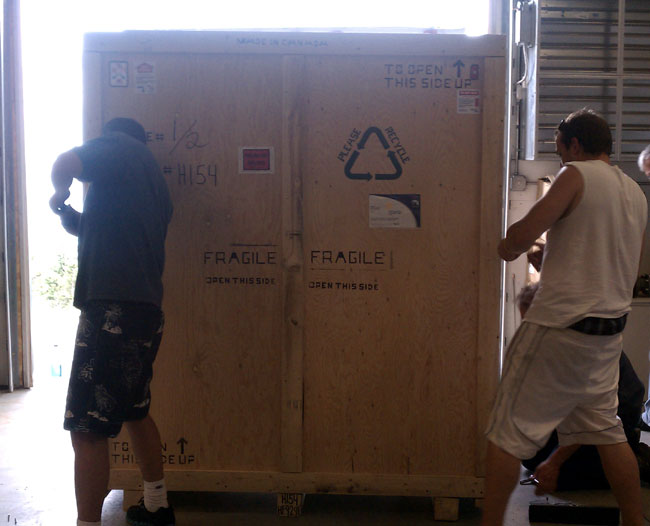
Unpacked:
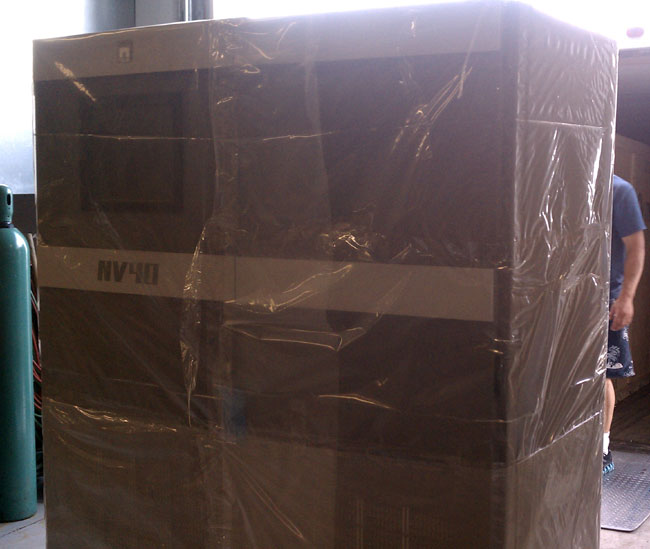
Moving into the final position in the WVPS transmitter room.
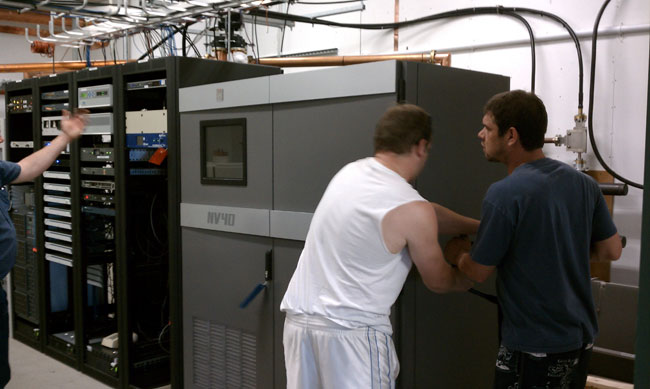
The connections were made to the transmitter, including connecting grounding strap to the back, 200 amp electrical service and the RF output connection via 3 inch rigid coax.
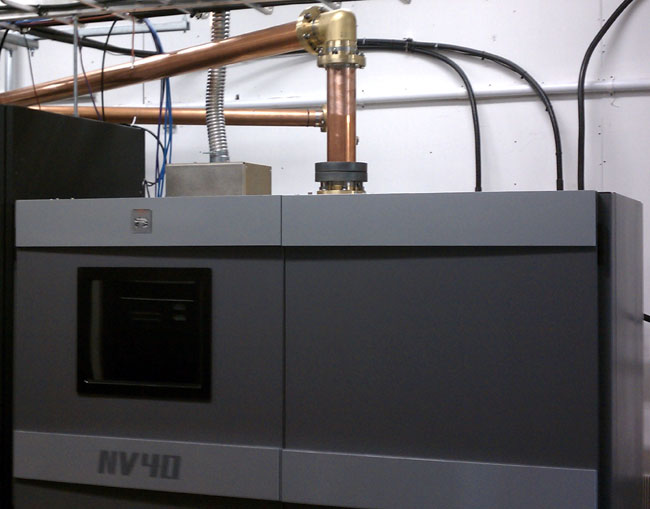
The remote control consists of basic transmitter functions going to a dial up Gentner remote control and a Network connection going to the GUI. The network connection allows persons on the network to use a web browser to look at the GUI. The HD radio connections are made via a HD radio importer and exporter, located at the studio, which also uses the network, via a connection on the exciters, to send the HD subchannel. The analog main channel is via an AES/EBU connection from the STL.
All connections go through large toroids to help isolate the transmitter from any lightning-related surges.
Before I left, we tested it at full TPO into the dummy load. All worked well, the only outstanding issue was getting the HD radio importer/exporters to work over the network, which was out of my jurisdiction.
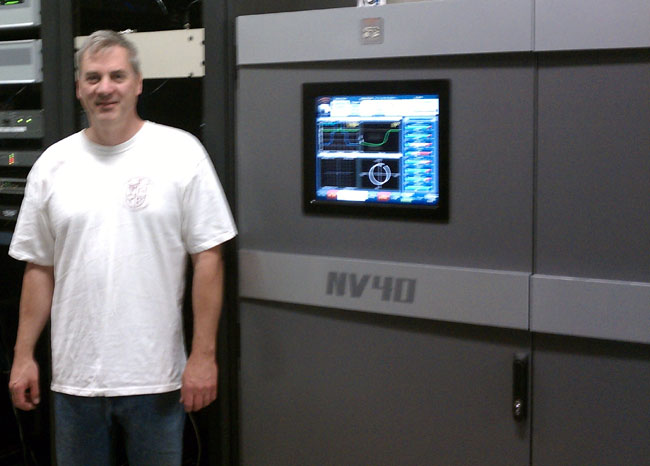
Here is a rather blurry picture of your author standing next to the NV-40 with the exciter and GUI turned on. There are to IEC power connectors at the top of the transmitter that go to the GUI and exciters. This allows those part of the transmitter to run on UPS’s, which is nice, being that the GUI takes about a minute to boot up after power failure.



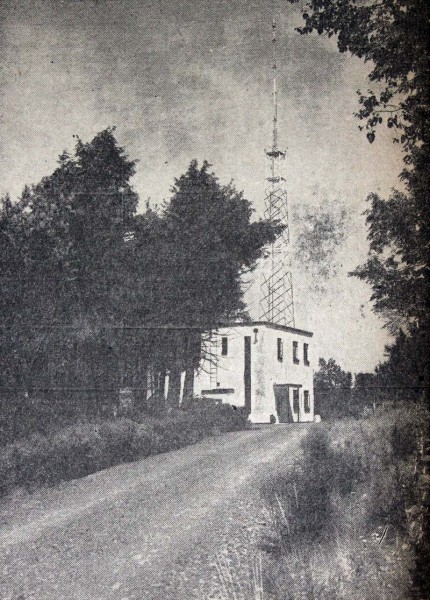
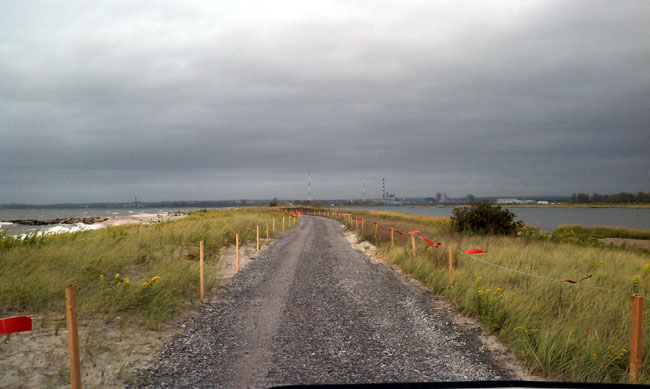

Blurry, but dead sexy!
That’s a heck of a control panel on that unit. Is that showing a spectral display in the upper, lefthand corner? And a constellation in the lower, righthand corner?
Thanks, Gary. The GUI is really quite impressive; spectral display upper left hand, constellation lower left hand, something else upper right hand and lissajous lower right hand. Keep in mind, the transmitter is off at this point. The display can also be changed to show bar graph meters for various transmitter functions, etc. It really is quite slick, runs on LINUX.
Sweet!
As if the above wasn’t cool enough!
Okay, enough geek drooling. Are the signals digitally generated (I & Q), then converted to analog for transmission?
Are the signals digitally generated (I & Q), then converted to analog for transmission?
Well, now you did it. I’ll have to go back to the manual and look that up.
The signals are digitally generated as I & Q at baseband, and then are digitally mixed up to the carrier frequency and converted to analog using a high-speed DAC. This signal is then filtered and used to drive the amplification stages directly. Because all of the generation and mixing is done digitally, none of the possible distortion inherent with an analog mixer is present.
3 1/8 transmission line its a little bit small for 40 kilowatts, 4 1/16 would have been better, dont you think.
You like the Nautel Transmitter? There is a lot of problem with that product that we dont like, its impressive for the display, but the rear pannel with a lot of screw, a lot of small supply for the amplifier, the over heat problem around the transmitter the impossibity to fix the exciter on a bench(without a connexion to the transmitter).
Nice installation
Regards
Your Canadian Friend!
@Sebastien – The Analog TPO is 26.5 KW, they are running their IBOC at -14dBc, so the power output is somewhere close to 28 KW, which is fine for 3 1/8 line. 4 1/16 line is standard with this transmitter.
Generally, I like the Nautel transmitter, although it’s only been on line for less than a month. Generally, I was a bit leery of the fancy GUI but it seems to work well. The back panel screws are a bit of a pain, that is true, this is a standard Nautel design. I use a cordless drill or power screwdriver to speed things up.
The individual PA power supplies provide good redundancy, I haven’t noticed any overheating problems nor exciter problems.
I haven’t come across any transmitters that I like better and there are several that are far worse.